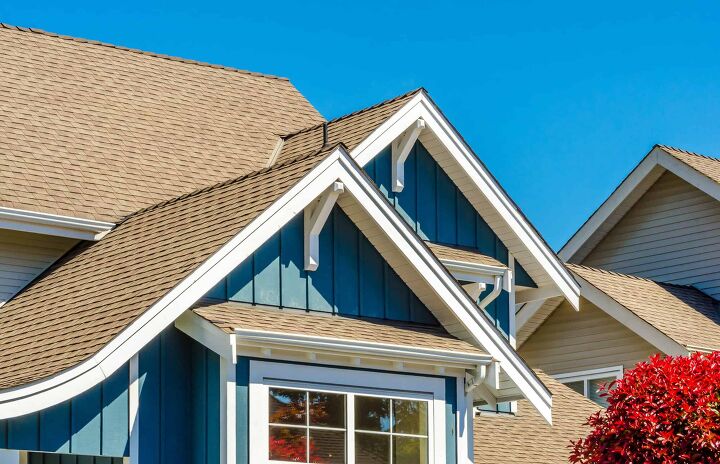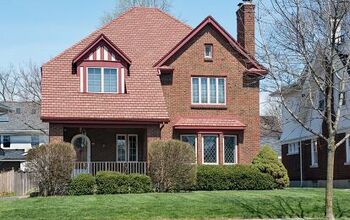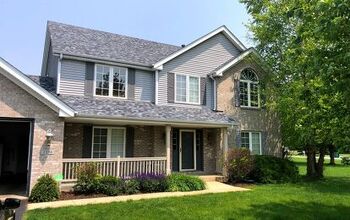What Is The Minimum Roof Pitch For Shingles?

Shingling a roof can be far more complicated than you may have realized. Because of the various materials involved, there are certain specifications that must be met to ensure that the roof and shingles are properly installed.
One of those specifications involves the pitch and slope of the asphalt shingle roof.
The minimum roof pitch that you should install shingles at is 2:12. Install the shingles at roughly 9 degrees and use a slope to be precise. It is common to install shingles at a roof pitch of 4/12 as the 2/12 roof pitch rule is only a minimum.
Do You Need Roofing Installation or Replacement?
Get free, zero-commitment quotes from pro contractors near you.

Normal and Low-Sloped Roof Installation
Normal shingle installation is allowable for any roof that has a pitch of at least 4:12. Whereas, the aforementioned 2:12 is the absolute minimum required for installing asphalt shingles. If the pitch is in the middle, there will need to be extra applications taken.
For a 3:12 pitch, for instance, you will need to have a double layer of asphalt-saturated felt paper or a layer of water and ice shield that sits underneath the shingle. Keep in mind that any roof that is just about the minimum may be better off using another roofing material rather than shingles.
What Angle is a 2:12 Pitch Roof?
The angle of a 2:12 pitch roof is roughly 9.46 degrees, rounded to 9.5 in most cases. For simplicity sake, every degree of pitch is roughly 4.75 degrees. The highest degree possible is a 45-degree roof which is a 12:12 pitch roof.
| Roof Pitch | Degree Angle |
| 1:12 | 4.76 |
| 2:12 | 9.46 |
| 3:12 | 14.04 |
| 4:12 | 18.43 |
| 5:12 | 22.62 |
| 6:12 | 26.57 |
| 7:12 | 30.26 |
| 8:12 | 33.69 |
| 9:12 | 36.87 |
| 10:12 | 39.81 |
| 11:12 | 42.51 |
| 12:12 | 45 |
The standard for roof pitch is 4:12, though a 2:12 is completely fine for most structures. When dipping below the minimum of a 2:12 pitch, roofs should be treated as flat and not use shingles as the material of choice.
Why is 2:12 the Minimum Pitch?
The problem with roofs that have very low slopes is simply gravity. At very low slopes, any water that collects on the roof whether it’s snow melt or rain, will drain very slowly. There is also a risk of lateral water movement both through and around where the shingles overlap. For this reason, it is always important to confirm the specific slope requirements of the manufacturer and also local building code.
Some shingle manufacturers may recommend a minimum slope that is higher than 2:12. Most manufacturer and industry requirements necessitate, or at least recommend, special underlayment or other considerations for roofs between 2:12 and 4:12. For slopes less than 2:12, you can install a granule-surfaced asphalt membrane instead of shingles.
Measuring Pitch
To calculate the pitch of a roof, you need to know the number of inches that it rises vertically for every 12 inches it extends horizontally. Knowing your roof’s pitch can be very helpful when you’re planning out an addition, renovating your roof, or even installing skylights. Here’s a very simple and safe way to determine roof pitch without having to climb up onto your roof:
- To calculate your roof’s pitch, you need either an 18- or 24-inch level, a pencil and a tape measure.
- To begin, use your tape measure to measure 12 inches from one end of your level. Mark this with your pencil.
- Then, inside your attic, position the end of the level against the base of one of roof rafter and hold it perfectly plumb.
- Measure in a vertical direction from the 12-inch mark you made on the level to the underside of the rafter. This measurement is the number of inches that your roof rises in 12 inches.
Roof Slope vs. Roof Pitch
A roof’s slope is generally defined by a rise-over-run ratio. For example, if you have roof that is measured at 12 inches along the base of the horizontal truss and its slope “rises” approximately 4 inches, the slope of that roof is 4:12, or 4 inches of rise per 12 inches of run.
It’s important to note that sometimes roof “pitch” is used in conjunction with roof slope. However, the roof’s pitch is technically measured and defined much differently. The pitch is the incline of the roof that is expressed as a fraction. In the example above, a roof with a slope of 4:12 has a pitch of 1:6, assuming that the span is twice the length of the run.
Although both roof pitch and roof slope describe the incline of a roof, they are calculated differently. Put simply, slope is expressed as a ratio in inches per square foot, whereas, pitch is a fraction that comes from dividing the rise by the entire span. The terms are very often used interchangeably but that is technically incorrect.
Can a Roof be Too Flat for Shingles?
Yes, anything under the minimum pitch requirement of 2:12 is too flat for the application of shingles. Flat roofing with shingles is definitely not advisable since the roof shingles aren’t sealed and will absolutely leak.
If you are dead set on having shingles on a flat roof, it is best if they are used simply for aesthetics. Install the flat roof first and then lay down the shingles of your choice over the top. Paying for the additional materials and installation can be quite costly, so it isn’t advisable to use shingles unless you are determined to get that visual for the flat roof.
What is the Best Material for a Low Pitch Roof?
For roofs that come in under the 2:12 minimum pitch requirement, the best kind of roofing is metal. There are copper and steel roofs that are great for shallow-pitched roofing. Metal roofing that has been installed properly can even go as low as 0.5:12 for pitch which is as close to flat as it gets without technically being flat.
Metal roofing is also highly durable and is great for helping to lower energy costs. Instead of modifying the roof or simply laying down shingles anyway, making a switch to copper or steel roofing can look great, provide a modern appeal, and help to cut down on energy costs.
While metal may be the best, the other roofing system options for low or flat roofs are as follows:
- TPO (thermoplastic polyolefin) is a white, single-ply membrane that is used on both residential and commercial roofs. Since the material is white, it does a great job at reflecting heat instead of absorbing it. For flat or low-sloped roofs that are over a bedroom, TPO is an excellent choice as it’ll keep the space cool. Though, you should keep I mind that the white membrane will get dirty easily.
- PVC (polyvinyl chloride) is also a white, single-ply membrane used on both residential and commercial roofs. It is also a great choice for flat or low-sloped roofs over a bedroom or a living space. Aside from chemical makeup PVC and TPO are very similar. Though, PVC has been around longer and is slightly more flexible.
- EPDM (ethylene propylene diene monomer) is a black, synthetic rubber membrane that is most commonly used for commercial roofs and roofs on medical facilities. Though, it can still be used for residential roofing. Since the membrane is black, it’s not ideal for installation over a living space or bedroom, as it will absorb heat. However, EPDM is a good choice for flat or low-sloped roofs over a garage or other non-living space. As an added bonus, the material is durable and won’t get as dirty as a white membrane.
Do You Need Roofing Installation or Replacement?
Get free, zero-commitment quotes from pro contractors near you.

Benefits of Using Asphalt Shingles
You may be wondering “why asphalt shingles?” The simple answer is that they are one of the most common roofing systems out there. They have been in use for hundreds of years, providing an effective material for homes and businesses alike.
The biggest reason that asphalt shingles are so common, primarily in residential areas, is that they are a cost-effective material. Costs can quickly escalate on roofing projects and finding quality materials that don’t run up the bill is an important factor.
The biggest advantage of asphalt shingle roofs is that they are easy to cut, fasten, and fit, making them ideal for do-it-yourself types looking to save on labor costs. Not everything in the home can be handled by an amateur, but an asphalt shingle roof can be reasonably and safely installed by anyone. Even better, they don’t require any kind of special roofing edges, chimney or vent flashings, or wall terminations to effectively install.
Best of all, asphalt shingles come in a huge array of textures, styles, and colors. This allows homeowners to get the precise look that they want, never having to settle for a look just because of limited options. Simply being able to choose the color, style, and texture is enough for many homeowners to make the switch to asphalt shingles.
The Durability of Asphalt Shingles
Not only are asphalt shingles quite cost-effective, they are also both easy to maintain and durable. The track record of asphalt shingles in North America is well-proven. It is not out of the question to get 30 or more years out of an asphalt shingle roof with the proper care and maintenance.
Best of all, unlike concrete and tile, they are much lighter in weight. This makes it easier to plug in new shingles without having to worry about the load capacity of your roof.
Asphalt shingles have excellent fire and uplift resistance as well. Asphalt shingles became an excellent form of protection from the elements, primarily fire which can engulf the wrong materials. There are also fewer leak issues with asphalt shingles. Any homeowner can attest to the nightmare that leaks can cause, from water damage to mold and a million other things in between.
Asphalt Shingles are Environmentally Friendly
There is a common misconception about the impact that asphalt shingles have on the environment. They aren’t bad for the environment; on the contrary, they are actually recyclable in most cases. When old roofing shingles get recycled, they can even be implemented in road repairs.
Knowing that the material you choose will be repurposed and reused later down the line can be an important factor. After all, a shingle roof will likely need to be replaced in a single lifetime and knowing that it isn’t sitting in a landfill somewhere can be an additional reason to choose that type of material.
Even better, most professional roofers will remove the old material and safely dispose of it for you. That provides reassurance that your new asphalt shingle roof is doing some good.
Downsides of Using Asphalt Shingles
Like any other material on the market, there are downsides to using asphalt shingles. The first is that they are susceptible to high winds and the damages that can happen. Strong winds can potentially bend or completely rip off asphalt shingles, leaving your roof exposed in the areas that have been damaged.
Asphalt shingles are also not the most energy-efficient option there is. They can trap and transfer solar energy into your home, making it more difficult to keep cool. Your HVAC system then has to work extra hard to ensure that the home stays cool, leading to an increase in energy costs.
Mildew is also a common issue with shingles that are consistently covered by shade. The coil, damp areas can trap moisture under the shingles with the mildew doing damage to both the roof and the shingle in the process.

Ryan Womeldorf has more than a decade of experience writing. He loves to blog about construction, plumbing, and other home topics. Ryan also loves hockey and a lifelong Buffalo sports fan.
More by Ryan Womeldorf



























